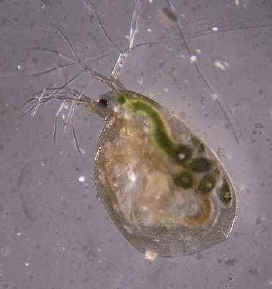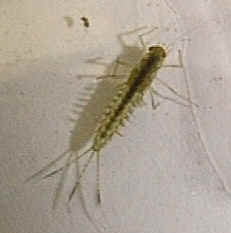 |
The open water in a wetland is seething with
plant and animal life. The water is full of tiny plants called algae, on which many of the
smaller animals feed. These smaller animals include the tiny dots you might see darting
around in the water, if you look very closely. These are called water fleas (Daphnia).
There are many different kinds of water fleas and there may be millions of them in the
water. If you look at the water fleas under a microscope, they prove to be as odd-looking as any alien. Because their bodies are transparent, you can even see the little green algae which they have been eating, in the top of their digestive system. |
 |
Also in the open water are a whole host of other small animals such as Mayfly (left) and Caddisfly larvae. These will be clinging to and feeding on the pondweed and other plants growing on the bottom of the open water area. Snails will also be slithering over the plants, rasping off and eating the algae which often coat the plant stems and leaves. Some of them also eat dead and decaying animals, which helps to recycle nutrients. The muddy bottom of the open water is also full of small creatures. These include Bloodworms, which are the larvae of a type of small fly called a midge, as well as the tiny delicate shells of freshwater cockles. The cockles look very similar to those you might find on a seashore, although much smaller.
|
 |
Hunting and eating all these small animals are a
great variety of larger ones. These include Dragonfly and Great Diving Beetle larvae,
bugs, such as Saucer Bugs and Water Scorpions (left), together with small fish such as
Sticklebacks. On the surface of the water, birds such as ducks and moorhens may be swimming about, while herons stand stock still, staring patiently into the water. They react in a fraction of a second to any passing fish, spearing their next meal with their long beaks. |